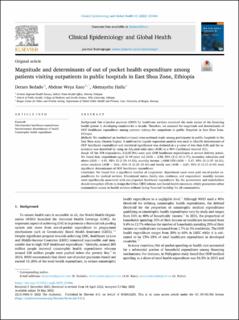Magnitude and determinants of out of pocket health expenditure among patients visiting outpatients in public hospitals in East Shoa Zone, Ethiopia
Journal article, Peer reviewed
Published version

Åpne
Permanent lenke
https://hdl.handle.net/11250/3040006Utgivelsesdato
2022Metadata
Vis full innførselSamlinger
Originalversjon
Clinical Epidemiology and Global Health. 2022, 15, 101066. 10.1016/j.cegh.2022.101066Sammendrag
Background
Out-of-pocket payment (OOP) for healthcare services remained the main means of the financing health system in developing countries for a decade. Therefore, we assessed the magnitude and determinants of OOP healthcare expenditure among patients visiting the outpatients in public Hospitals in East Shoa Zone, Ethiopia.
Methods
We conducted an institution-based cross-sectional study among participants in public hospitals in the East Shoa zone, Oromia Region. A multivariate logistic regression analysis was used to identify determinants of OOP healthcare expenditure and statistical significance was declared at a p-value of less than 0.05 and the association was described by using an Adjusted odds ratio (AOR) at a 95% Confidence Interval (CI).
Result
Of the 378 respondents, 332(87.8%) were paid OOP healthcare expenditures at service delivery points. We found that, respondents aged 31-49 years old (AOR = 2.58, 95% CI (1.16–5.77), secondary education and above (AOR = 4.85, 95% CI (1.59–14.83), monthly income ≥4000 ETB (AOR = 5.67, 95% CI (1.97–16.31), urban residents (AOR = 3.61, 95% CI (1.29–10.16) and family size (AOR = 2.67, 95% CI (1.11–6.44) were significant determinants of OOP healthcare expenditure.
Conclusion
We found that a significant number of outpatients' department users were paid out-of-pocket expenditures for medical services. Educational status, family size, residence, and respondents’ monthly income were significantly associated with out-of-pocket healthcare expenditure. So, the government and stakeholders should strengthen efforts to design the Urban CBHI scheme and Social health insurance, which guarantees urban communities access to health services without facing financial hardship for all communities.
